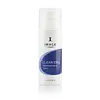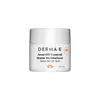What's inside
What's inside
 Key Ingredients
Key Ingredients

 Benefits
Benefits

 Concerns
Concerns

 Ingredients Side-by-side
Ingredients Side-by-side

Benzoyl Peroxide 5%
Water
Skin ConditioningCaprylic/Capric Triglyceride
MaskingOligopeptide-10
AntimicrobialCetearyl Olivate
Syringa Vulgaris Extract
Skin ConditioningChamomilla Recutita Flower Extract
MaskingOryza Sativa Bran Extract
Skin ConditioningSorbitan Olivate
EmulsifyingAloe Barbadensis Leaf Extract
EmollientStearic Acid
CleansingSucrose Cocoate
EmulsifyingTocopheryl Acetate
AntioxidantMaltodextrin
AbsorbentMelaleuca Alternifolia Leaf Oil
AntioxidantMentha Viridis Leaf Oil
AstringentDisodium EDTA
Eucalyptus Globulus Leaf Oil
PerfumingArnica Montana Flower Extract
MaskingAesculus Hippocastanum Extract
AntioxidantMelia Azadirachta Leaf Extract
Skin ConditioningBoswellia Serrata Extract
Skin ConditioningHoney Extract
HumectantCamellia Sinensis Leaf Extract
AntimicrobialPotassium Sorbate
PreservativeSodium Benzoate
MaskingButylene Glycol
HumectantPhenoxyethanol
PreservativeCaprylyl Glycol
EmollientHexylene Glycol
EmulsifyingBenzoyl Peroxide 5%, Water, Caprylic/Capric Triglyceride, Oligopeptide-10, Cetearyl Olivate, Syringa Vulgaris Extract, Chamomilla Recutita Flower Extract, Oryza Sativa Bran Extract, Sorbitan Olivate, Aloe Barbadensis Leaf Extract, Stearic Acid, Sucrose Cocoate, Tocopheryl Acetate, Maltodextrin, Melaleuca Alternifolia Leaf Oil, Mentha Viridis Leaf Oil, Disodium EDTA, Eucalyptus Globulus Leaf Oil, Arnica Montana Flower Extract, Aesculus Hippocastanum Extract, Melia Azadirachta Leaf Extract, Boswellia Serrata Extract, Honey Extract, Camellia Sinensis Leaf Extract, Potassium Sorbate, Sodium Benzoate, Butylene Glycol, Phenoxyethanol, Caprylyl Glycol, Hexylene Glycol
Salicylic Acid 0.53%
MaskingWater
Skin ConditioningStearic Acid
CleansingCaprylic/Capric Triglyceride
MaskingCetyl Alcohol
EmollientGlyceryl Stearate Citrate
EmollientMelaleuca Alternifolia Leaf Oil
AntioxidantGlycerin
HumectantPolysorbate 60
EmulsifyingSalix Alba Bark Extract
AstringentAniba Rosodora Wood Oil
AstringentSimmondsia Chinensis Seed Oil
EmollientChamomilla Recutita Flower Extract
MaskingAloe Barbadensis Extract
Skin ConditioningAllantoin
Skin ConditioningPanthenol
Skin ConditioningXanthan Gum
EmulsifyingPolysorbate 20
EmulsifyingGlyceryl Stearate
EmollientCetearyl Glucoside
EmulsifyingPotassium Sorbate
PreservativePhenoxyethanol
PreservativeEthylhexylglycerin
Skin ConditioningLavandula Angustifolia Oil
MaskingSalicylic Acid 0.53%, Water, Stearic Acid, Caprylic/Capric Triglyceride, Cetyl Alcohol, Glyceryl Stearate Citrate, Melaleuca Alternifolia Leaf Oil, Glycerin, Polysorbate 60, Salix Alba Bark Extract, Aniba Rosodora Wood Oil, Simmondsia Chinensis Seed Oil, Chamomilla Recutita Flower Extract, Aloe Barbadensis Extract, Allantoin, Panthenol, Xanthan Gum, Polysorbate 20, Glyceryl Stearate, Cetearyl Glucoside, Potassium Sorbate, Phenoxyethanol, Ethylhexylglycerin, Lavandula Angustifolia Oil
Alternatives
Ingredients Explained
These ingredients are found in both products.
Ingredients higher up in an ingredient list are typically present in a larger amount.
This ingredient is an emollient, solvent, and texture enhancer. It is considered a skin-softener by helping the skin prevent moisture loss.
It helps thicken a product's formula and makes it easier to spread by dissolving clumping compounds.
Caprylic Triglyceride is made by combining glycerin with coconut oil, forming a clear liquid.
While there is an assumption Caprylic Triglyceride can clog pores due to it being derived from coconut oil, there is no research supporting this.
Learn more about Caprylic/Capric TriglycerideChamomilla Recutita Flower Extract comes from the Chamomile flower.
Chamomile is rich in antioxidants and has anti-inflammatory properties. Several compounds found in chamomile help with soothing, such as bisbolol.
Antioxidant components in chamomile make it an effective ingredient to help slow the signs of aging. Antioxidants help fight free-radical molecules, or molecules that may damage your skin.
Essential oils from chamomile have been found to improve wound healing due to its antimicrobial properties.
Ancient Greeks and Egyptians used Chamomile to treat skin redness and dryness. Chamomile has also been used to help treat stomach issues.
Learn more about Chamomilla Recutita Flower ExtractThis tea tree oil comes from the leaves of the Tea Tree plant. Tea tree oil has antioxidant, anti-inflammatory, and antimicrobial properties.
According to the book Journal of Profiles of Drug Substances, tea tree helps in reducing acne-causing bacteria such as Propionibacterium acnes. This is due to the Terpinen components of tea tree oil.
Tea tree may cause sensitivity and irritation for some people. This oil naturally contains fragrance such as linalool and limonene.
However, research shows irritation usually occurs when using pure tea tree oil and not in cosmetic products.
Tea tree oil was found to help relieve the symptoms of psoriasis in one study.
Tea tree oil is toxic when ingested. Another study showed it to caused damage to the nervous system of dogs and cats when applied to their skin or given orally.
Learn more about Melaleuca Alternifolia Leaf OilPhenoxyethanol is a preservative that has germicide, antimicrobial, and aromatic properties. Studies show that phenoxyethanol can prevent microbial growth. By itself, it has a scent that is similar to that of a rose.
It's often used in formulations along with Caprylyl Glycol to preserve the shelf life of products.
Potassium Sorbate is a preservative used to prevent yeast and mold in products. It is commonly found in both cosmetic and food products.
This ingredient comes from potassium salt derived from sorbic acid. Sorbic acid is a natural antibiotic and effective against fungus.
Both potassium sorbate and sorbic acid can be found in baked goods, cheeses, dried meats, dried fruit, ice cream, pickles, wine, yogurt, and more.
You'll often find this ingredient used with other preservatives.
Learn more about Potassium SorbateStearic Acid is a fatty acid. It is an emollient, emulsifier, and texture enhancer.
As an emollient, stearic acid helps soften skin. It aids the skin's protective barrier by preventing water loss. It also provides a gentle cleansing effect without stripping away natural oils.
Stearic acid may also be used to enhance the texture of products. It can add volume and stabilize ingredients such as water and oil. This can help water and oil ingredients from separating.
Sources of stearic acid include animal or vegetable fats/oils such as coconut or shea. It can be naturally found in butter, cocoa butter, shea butter, vegetable fats, and animal tallow.
This ingredient may not be Malassezia folliculitis, or fungal-acne safe.
Learn more about Stearic AcidWater. It's the most common cosmetic ingredient of all. You'll usually see it at the top of ingredient lists, meaning that it makes up the largest part of the product.
So why is it so popular? Water most often acts as a solvent - this means that it helps dissolve other ingredients into the formulation.
You'll also recognize water as that liquid we all need to stay alive. If you see this, drink a glass of water. Stay hydrated!
Learn more about Water